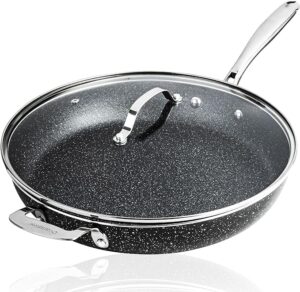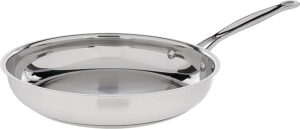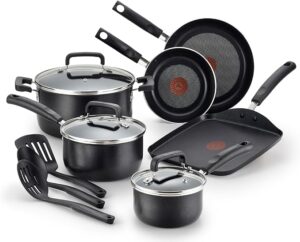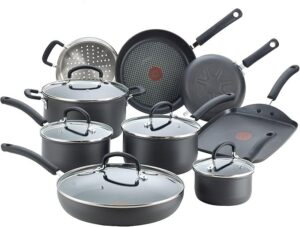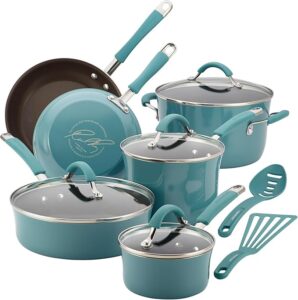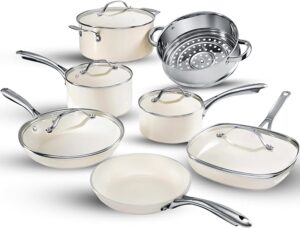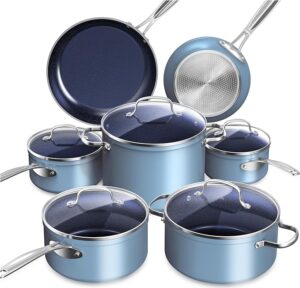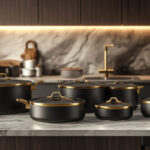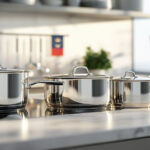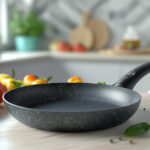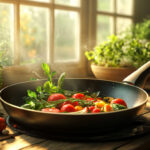Is Tefal Cookware Safe? Understanding the Materials and Safety of Non-Stick Pans

Safety ranks among the first criteria in cookware, especially among non-stick options. Being one of the leading brands, many cooks ask themselves the question of “Is Tefal cookware safe?” Tefal is one of the leading brands for non-stick pans, which make cooking and cleaning just a breeze, but about the material used internally-popularly known as Teflon, or scientifically referred to as PTFE-questions arise. It will consider in this guide the materials used by Tefal for their cookware, how safe their no-stick coating is, and how usage and proper maintenance could keep healthy your cookware for a reliable share of your kitchen.
The Evolution of Non-Stick Cookware: From PTFE to Ceramic
But years of improvement in non-stick cookware have tended to not only performance but also safety issues. When non-stick cookware became really popular in the 20th century, it relied on a synthetic polymer called PTFE-popularly by its brand name of Teflon. PTFE gave a really efficient non-stick surface that made cooking and cleaning a lot easier. There were, however, some question marks over the safety of this non-stick coating, particularly when this was subjected to overheating. Over 500°F, PTFE breaks down and can release fumes that may be harmful if inhaled. Despite this, modern Tefal cookware made with PTFE is considered safe for everyday use, provided the cookware is not exposed to extremely high temperatures and is used properly.
Due to consumer demand for safety and concern for the environment, most manufacturers, including Tefal, began releasing a variety of non-stick cookware using ceramic coatings. Ceramic non-stick pans are often touted as PTFE- and PFOA-free; the latter was another chemical previously used in the manufacturing process of non-stick coatings. Ceramic coatings are primarily a product of silica, derived from sand, and provide a toxic-free, heat-resistant surface. While they do not emit harmful fumes at extreme temperatures, as it does, and ceramic coatings wear off faster, hence, being less durable over time when compared to traditional PTFE-based non-stick pans.
This goes to mean that when answering the question, “Is Tefal cookware safe?”, both the PTFE and ceramic coatings can be safe if put into historical context regarding their evolution as non-stick materials. Since Tefal has continued in technological improvements regarding its nonstick coatings to ensure they remain safe, PFOA-free, and durable.
Whether you like the durability of PTFE or the greener appeal of ceramic, taking good care-such as avoiding metal utensils and cooking over moderate heat-will maximize both the safety and lifespan of your nonstick cookware.
What Chemicals Have Been Removed from Tefal Cookware?
Tefal has gone to great lengths to ensure safety with the removal of quite a few harmful chemicals in their manufacturing process. It stopped using PFOA, or perfluorooctanoic acid, which had been widely used in the production of its non-stick coating layer. PFOA was linked with developmental problems and certain cancers. As Tefal is committed to safety, all its non-stick cookware range is PFOA-free, meeting even more stringent health regulations and increasing consumer demands for healthier cookware.
Tefal has also excluded several other toxic materials from its cookwares apart from PFOA. This includes exclusion of lead and cadmium, two heavy metals which are capable of divulging quite critical health hazards. With this act, Tefal cleans up its products and raises the quality and safety bars on cookware to such an extent that it would enable consumers to cook foods without thinking about contaminating food with noxious chemicals.
Tefal has further adopted high-tech non-stick coatings with a focus on durability and safety without any compromise in performance. Recent formulations have been done for higher temperatures, and product lines featuring a PTFE-free cooking surface have resulted in addressing consumer concerns about overheating. Overall, the proactive effort at removing these harmful chemicals ensures that Tefal’s cookware will be safe and reliable for daily use.
Safety Concerns: Avoiding Overheating and Toxic Fumes
Because of this, cooking technology has literally changed the game for many home chefs because nonstick cookware, such as Tefal cookware, can now easily be used. A few points of safety concern are to be taken into consideration. Of the chief among various issues with non-stick pans, overheating and the subsequent release of toxic fumes have been an issue. Understanding these risks and how to avoid them will help guarantee that a safe cooking environment is kept.
Non-Stick Cookware Dangers
One of the biggest risks associated with non-stick pans involves overheating. The older non-stick coatings made using PTFE-polytetrafluoroethylene-have the tendency to degrade at temperatures above 500°F or 260°C, thus releasing toxic fumes. These fumes are toxic to humans and pets, especially birds, since they are very sensitive to air quality. Most manufacturers, like Tefal, have come up with new and more temperature-stable coatings in light of these concerns; however, it is very important that cooks are aware of this overheating risk and conduct activities within the limits of safe use.
How to Avoid Toxic Fumes from Pans
Following are some of the effective ways to avoid the toxic fumes from pans so that one can enjoy the benefits of non-stick cookware while minimizing safety risks:
1. Use Proper Heat Settings: While cooking with non-stick pans, one should always use medium to low heat. High heat will surely result in overheating in very little time, hence producing toxic fumes. Tefal cookware does not require high temperatures since it performs quite well at lower temperatures.
2. Be Cautious with the Cooking Time: Never leave a non-stick pan unattended while it is on the stove, especially on high heat. Keep an eye on what you are cooking and take the pan off the heat once you start to see smoke coming out of the food.
3. Preheating Wisely: If you need to preheat your non-stick pan, do so briefly. You really don’t have to preheat an empty non-stick pan for such a long period of time. Instead, you should heat the pan for just a minute or two before adding in your ingredients.
4. Use Correct Utensils: Use only wooden, silicone, or plastic utensils, as metal scratches the surface of a nonstick pan, which over time will degrade it. Once the coating has become scratched, chipped, or flaked, it can’t be scratched with metal and is thus damaged, compromising the coating that could potentially release fumes.
5. Care and Cleaning: Regularly check your non-stick cookware for any scratches or other forms of damage. Clean them according to the manufacturer’s guidelines to avoid using abrasive materials that wear the coating down.
6. Ventilation is Key: Your kitchen should always be well-ventilated when cooking. Utilize exhaust fans or open windows to dissipate fumes and make the cooking environment safe.
Following these recommendations makes it possible to have all the convenience of using non-stick cookware, such as Tefal pans, and minimize as much as possible the risks from overheating with toxic fumes. More importantly, by knowing safe practices, you will then be confident with the use of these versatile tools when cooking and know that your health and safety in the kitchen come first.

How to Use and Care for Non-Stick Pans Safely
Proper care and proper usage of the pan are the two ‘must-observe’ measures to extend its life and to create a cooking environment free from any probable hazards. The following will be a comprehensive approach towards using and caring for the non-stick pan safely.
1. Choosing the Right Utensils
- Avoid Using of Metal Utensils: Wood, silicone, or plastic is always better not to scratch the non-stick surface. Scratches, which are made by metal utensils, compromise the coating for some time and can make it detach in pieces, which impairs its performance.
2. Cooking Temperatures
- Avoid High Heat: Non-stick pans always are to be used over medium to low heat. If one continuously cooks at very high levels of heat, then the non-stick coating used tends to deteriorate and certain fumes can release, which are harmful. One should always try to maintain the level of heat at medium levels.
3. Preheating Guidelines
- Preheat Wisely: When you need to preheat your non-stick pan, do this for only a short time, like 1 to 2 minutes, and then add in your ingredients. Do not preheat an empty non-stick pan for extended periods of time.
4. With Oil or Butter
- Less Fat Needed: A non-stick pan is, by definition, supposed to use less added fat, but there will be a need for a small amount of oil or butter to enhance flavor and to prevent sticking. In fact, it is quite all right to lightly coat the surface with any greasy substance before adding food.
5. Cleaning and Maintenance
- Gentle Cleaning: Allow the pan to cool after cooking. Use soapy, warm water and a soft sponge or cloth to clean off the surface. Avoid using an abrasive pad or cleaner that can damage the coating.
- Non-stick pan in a Dishwasher: Even though some non-stick pans claim to be dishwasher safe, it is generally advisable not to put them through a dishwasher and instead wash them by hand for longevity. In the dishwasher, they can be placed on the very top rack away from direct heat.
6. Storage Practices
- Avoid Stacking: Stack your non-stick pans only when absolutely necessary and place a soft cloth or paper towel between them to prevent scratches. Do not stack heavy items on top of your non-stick cookware.
7. Checks for Damage
- Regular Inspections: Regularly inspect your non-stick pans for scratches, chips, or other manners of wear. If the coating is damaged, it may be time for a new pan to come in and avoid potential health risks.
8. Ventilation While Cooking
- Proper Ventilation: Cook in a well-ventilated environment to disperse fumes that might show up when overheating your pan. Utilize exhaust fans and open windows for good air quality.
9. Cooking Sprays
- Avoid Cooking Sprays: Most of them contain residue that may build up and used over time to facilitate a catalyst for a non-stick surface to become less effective. Instead, just use a little bit of oil or butter when necessary.
Just be aware that following such advice indeed prolongs the life of your non-stick pans and enables safe food preparation. Proper maintenance improves performances and allows you to avoid all the potential dangers related to cookware coated with a non-stick layer. Now, enjoy the convenience and ease brought to your house by the non-stick pan, but always keep safety and maintenance in mind!
Are Tefal Pans Oven-Safe? What You Need to Know
Since versatile cookware is involved, many home chefs have asked themselves, “Is Tefal cookware safe?” The most frequent question in the minds of these enthusiasts will be whether Tefal pans are oven safe or not. It is relevant to the understanding of safety and usability that Tefal cookware will have in the oven for those that would wish to expand their cooking techniques and make full use of their kitchen tools.
Oven-Safe Features of Tefal Pans
Overall, Tefal pans are built to be tough and help in cooking. Many of its products support oven safety. Oven safety in the case of Tefal cookware may mean a number of things depending on a particular model and materials being used. For example, some stainless steel pans by Tefal and some aluminum pans generally withstand oven temperature to about 350°F/175°C or more and therefore will be suitable for a great variety of baking and roasting tasks. Conversely, some non-stick pans may have limitations to a maximum temperature; hence, it would be better to refer to the manufacturer’s guidelines or the care instructions that come with your cookware.
Material Considerations
When asking, “Is Tefal cookware safe?” in the context of oven use, it is relevant to point out that the question should address the materials used in the construction of the pans. Tefal cookware usually is coated with non-stick coatings that are sensitive at high temperatures. Although modern non-stick pans by Tefal are built to handle temperature better than previous designs, it is still quite all right to avoid high temperatures beyond its limits; this will likely result in the breakdown of the coating and probably harmful fumes being released.
Recommendations for Safe Use
A few suggestions to ensure that the Tefal pans can be used safely in the oven:
1. Manufacturer Instructions: Always refer to the specific instructions on the cookware that you have purchased since these will clearly state the temperature limit beyond which your pan should not go and if it is oven-safe.
2. Avoid Broiling: Even though your Tefal pan is oven-safe, using it under the broiler is generally to be avoided because that would provide extreme and direct heat to the pan that may well be in excess of the permissible temperature limits.
3. Be Cautious about Non-Stick Coating: For Tefal non-stick-coated pans, one should be aware of the maximum temperature beyond which coating degradation starts to take place.
4. Note the Handles: A number of Tefal pans have handles that could be of materials not meant to go into an oven. Always verify if the handles are oven-safe before putting your pan into the oven.
In the end, most Tefal pans are oven-friendly and designed to improve your cooking experience. One just needs to learn about the product-specific instructions and the materials the pan is made of. This will answer the most important question: “Is Tefal cookware safe?” In this respect, paying attention to details will let you bake with your Tefal pan, roast in it, or make other dishes while being safe and performing well in the kitchen.

